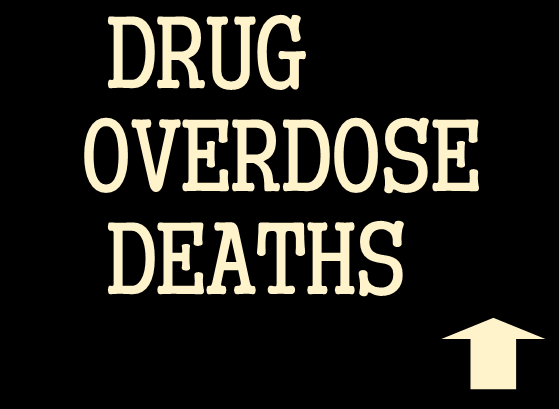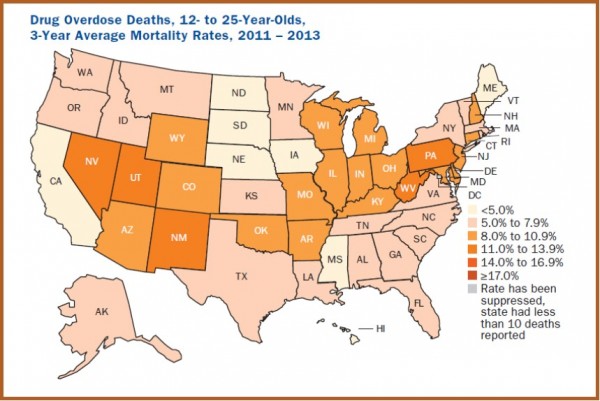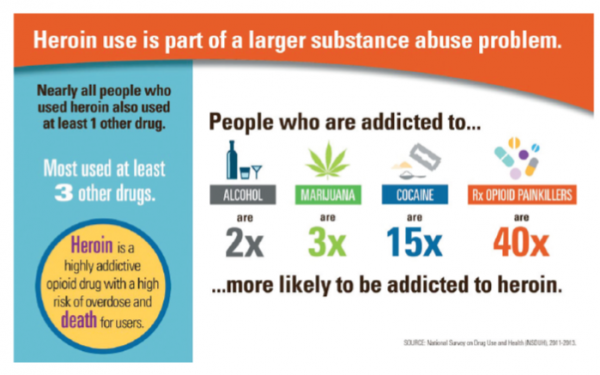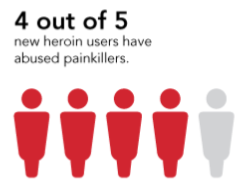CT Drug Overdose Death Rate Above National Average, 20th Highest in US; Doubles Since 2001
/In every state, the rate of young people dying from drug overdoses increased in the past decade, according to a report by Trust for America’s Health. In the past 12 years, the overdose rate for people ages 12 to 25 has more than doubled in 35 states and quadrupled in five, Governing magazine reported. In 1999, not one state had a drug overdose death rate of more than 6.1 per 100,000 young adults. Fast forward 14 years, and 33 states had drug overdose deaths of 6.1 per 100,000 or higher from 2011 to 2013. The national average is now 7.3 per 100,000 youths. In Connecticut, the average rate between 1999 and 2001 was 4.1 per 100,000. Between 2010 and 2013, the drug overdose rate had risen to 8.3, above the national aver
In Connecticut, the average rate between 1999 and 2001 was 4.1 per 100,000. Between 2010 and 2013, the drug overdose rate had risen to 8.3, above the national aver age but unchanged from a previous three-year period, 2005-2007. The data was compiled from the Centers for Disease Control and Prevention. Males are 2.5 times as likely to overdose as females (10.4 vs. 4.1 per 100,000), according to the report.
age but unchanged from a previous three-year period, 2005-2007. The data was compiled from the Centers for Disease Control and Prevention. Males are 2.5 times as likely to overdose as females (10.4 vs. 4.1 per 100,000), according to the report.
In a report this month, Reducing Teen Substance Misuse: What Really Works, Connecticut ranked 31st lowest (20th highest) for the number of youth drug overdose deaths, with the rate of 8.3 per 100,000 youth, ages 12 to 25. Connecticut is one of 18 states where the overdose death rates have more than doubled in the past dozen years, according to the report.
West Virginia, New Mexico and Utah have the highest rates of young adult overdose deaths, with each around 12 deaths per 100,000 youths in 2013. This is more than five times higher than South Dakota, North Dakota and Nebraska, which had rates around 3 deaths per 100,000 teens and young adults.
The statistics, and the use of opiates and heroin across the country, have been featured in recent weeks on 60 Minutes and The New York Times, focusing on Ohio and New Hampshire, respectively. Both reports indicated it is a national problem of unprecedented proportion. 
Drug overdose death rates have increased everywhere since 1999, but the rate has gone down Florida, Louisiana, Maine, Mississippi and Tennessee in the past 8 years. Nevertheless, the rate increased in 13 states since 2007 -- and 11 of those states have overdose death rates above 6.1 per 100,000.
In July, Governor Malloy hosted a bill signing ceremony at a New London treatment center to commemorate the final passage of legislation he introduced aimed at reducing heroin and prescription opioid abuse. The legislation law improves the prescription monitoring program and prescribing practices, with increased education and tools available to health care professionals, and greater accessibility of the overdose reversing drug naloxone in cases of emergency, according to the Governor’s office.
"We have to treat addiction like a public health issue not a crime,” Malloy said. “Connecticut is taking a stand against a nationwide prescription opioid and heroin overdose epidemic to become a leader in combating opioid and heroin abuse, preventing drug addiction and overdoses. This common sense legislation will help save lives and address a pressing public health need."
The legislation streamlines the proces s to help practitioners identify potential abuse that leads to over prescribing by requiring them to check patient history to verify if patients seeking certain prescriptions have recently received these medications from multiple other prescribers or pharmacists.
s to help practitioners identify potential abuse that leads to over prescribing by requiring them to check patient history to verify if patients seeking certain prescriptions have recently received these medications from multiple other prescribers or pharmacists.
Under the Connecticut law, in cases of overdose or medical emergency, the drug naloxone will be more widely available, allowing pharmacists, after being trained and certified to prescribe it to Connecticut families, first responders, and the treatment community across the state. In Connecticut, State Police Troopers have saved more than 30 lives from drug overdose by administering NARCAN.
The Reducing Teen Substance Misuse report also includes a review of 10 key indicators of leading evidence-based policies and programs that can improve the well-being of children and youth and have been connected with preventing and reducing substance— alcohol, tobacco or other drugs—misuse. Connecticut was one of two states scoring nine out of 10 and, nationally, 24 states scored a five or lower. Minnesota and New Jersey received the highest score of 10 out of a possible 10 points, while four states scored the lowest, Idaho, Louisiana, Mississippi and Wyoming, with three out of 10 points, according to the report.
Those states with drug overdose death rates above the national average, in addition to Connecticut, include Arizona, Arkansas, Colorado, Delaware, Illinois, Indiana, Kentucky, Maryland, Massachusetts, Michigan, Missouri, Nevada, New Hampshire, New Jersey, New Mexico, Ohio, Oklahoma, Pennsylvania, Utah, West Virginia, Wisconsin and Wyoming.
Rates have more than tripled in twelve states (Arkansas, Delaware, Indiana, Iowa, Michigan, Minnesota, Missouri, New Hampshire, New York, Oklahoma, Utah and West Virginia); and more than quadrupled in five states (Kansas, Montana, Ohio, Wisconsin and Wyoming).
Overall, the report found a significant jump in overdoses from teen to young adult years. Overdose rates for 19- to 25-year-olds are eight times greater than people 18 and younger. There isn’t a clear answer for why heroin addiction and overdose deaths have grown so dramatically, although the availability of prescription drugs might have something to do with it, Governing reported.
The New York Times reported that:
- Heroin-related deaths jumped 39 percent from 2012 to 2013, and the longer-term trends are equally disturbing: from 2002 to 2013, the rate of heroin-related overdose deaths nearly quadrupled, according to the Centers for Disease Control and Prevention.
- Researchers have found that prior to the 1980s, whites and nonwhites were equally represented among first-time heroin users. Now, nearly 90 percent of the people who tried heroin for the first time in the past decade were white. And a growing number are middle-class or wealthy.
- Three out of four heroin addicts started out by using prescription drugs. The C.D.C. reports that 45 percent of people who used heroin between 2011 and 2013 were also addicted to prescription painkillers. People who are dependent on prescription opioids are 40 times more likely to abuse or be dependent on heroin, according to the C.D.C.
- Opioid deaths were up 76 percent in New Hampshire in 2014, with 325 people dying from an opioid overdose, according to state figures. Emergency room visits from heroin have more than tripled there since 2013. In Massachusetts, opioid deaths rose 20 percent in 2014, and are up 63 percent over 2012, The Boston Globe reported.
https://youtu.be/CQFITcdG8_4





























